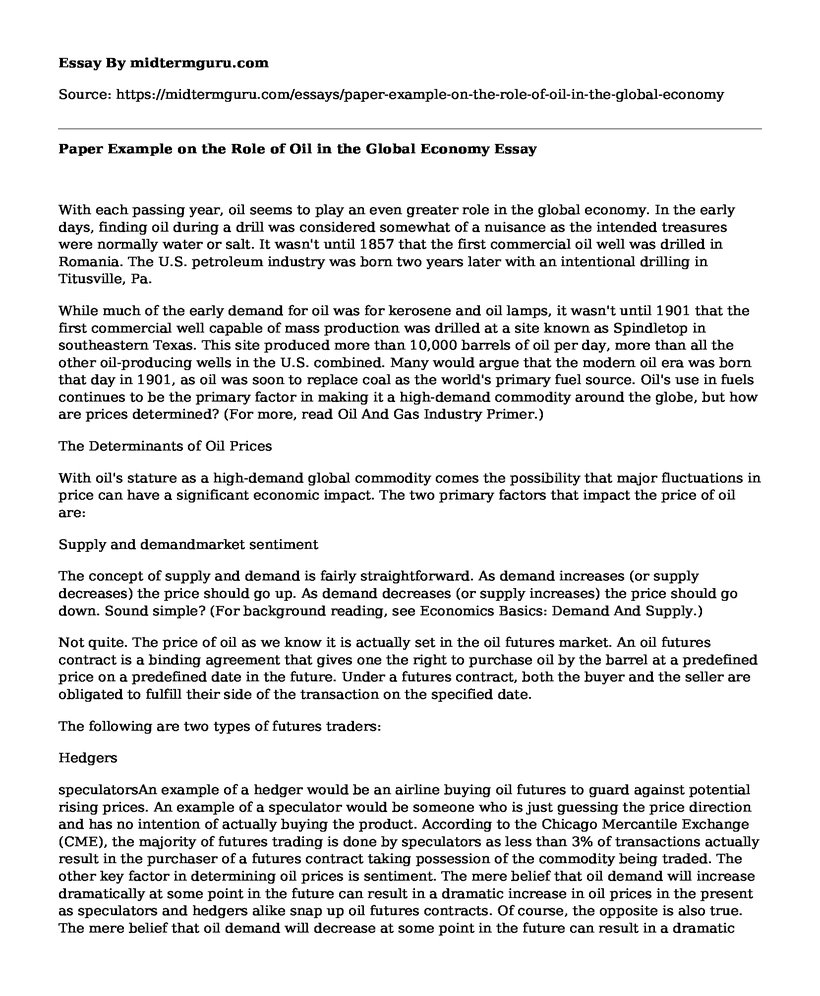With each passing year, oil seems to play an even greater role in the global economy. In the early days, finding oil during a drill was considered somewhat of a nuisance as the intended treasures were normally water or salt. It wasn't until 1857 that the first commercial oil well was drilled in Romania. The U.S. petroleum industry was born two years later with an intentional drilling in Titusville, Pa.
While much of the early demand for oil was for kerosene and oil lamps, it wasn't until 1901 that the first commercial well capable of mass production was drilled at a site known as Spindletop in southeastern Texas. This site produced more than 10,000 barrels of oil per day, more than all the other oil-producing wells in the U.S. combined. Many would argue that the modern oil era was born that day in 1901, as oil was soon to replace coal as the world's primary fuel source. Oil's use in fuels continues to be the primary factor in making it a high-demand commodity around the globe, but how are prices determined? (For more, read Oil And Gas Industry Primer.)
The Determinants of Oil Prices
With oil's stature as a high-demand global commodity comes the possibility that major fluctuations in price can have a significant economic impact. The two primary factors that impact the price of oil are:
Supply and demandmarket sentiment
The concept of supply and demand is fairly straightforward. As demand increases (or supply decreases) the price should go up. As demand decreases (or supply increases) the price should go down. Sound simple? (For background reading, see Economics Basics: Demand And Supply.)
Not quite. The price of oil as we know it is actually set in the oil futures market. An oil futures contract is a binding agreement that gives one the right to purchase oil by the barrel at a predefined price on a predefined date in the future. Under a futures contract, both the buyer and the seller are obligated to fulfill their side of the transaction on the specified date.
The following are two types of futures traders:
Hedgers
speculatorsAn example of a hedger would be an airline buying oil futures to guard against potential rising prices. An example of a speculator would be someone who is just guessing the price direction and has no intention of actually buying the product. According to the Chicago Mercantile Exchange (CME), the majority of futures trading is done by speculators as less than 3% of transactions actually result in the purchaser of a futures contract taking possession of the commodity being traded. The other key factor in determining oil prices is sentiment. The mere belief that oil demand will increase dramatically at some point in the future can result in a dramatic increase in oil prices in the present as speculators and hedgers alike snap up oil futures contracts. Of course, the opposite is also true. The mere belief that oil demand will decrease at some point in the future can result in a dramatic decrease in prices in the present as oil futures contracts are sold (possibly sold short as well).
Price Cycle
Additionally, from a historical perspective, there appears to be a possible 29-year (plus or minus one or two years) cycle that governs the behavior of commodity prices in general. Since the beginning of oil's rise as a high-demand commodity in the early 1900s, major peaks in the commodities index have occurred in 1920, 1951 and 1980. Oil peaked with the commodities index in both 1920 and 1980. (Note: there was no real peak in oil in 1951 because it had been moving in a sideways trend since 1948 and continued to do so through 1968.) It is important to note that supply, demand and sentiment take precedence over cycles because cycles are just guidelines, not rules. (Find out how to invest and protect your investments in this slippery sector in Peak Oil: What To Do When The Well Runs Dry.)
If one wishes to pursue his or her education of oil beyond this brief introduction, recommended educational material on oil can be obtained directly from OPEC. Information on the oil futures market can be obtained through the CME.
Conclusion
Unlike most products, oil prices are not determined entirely by supply, demand and market sentiment toward the physical product. Rather, supply, demand and sentiment toward oil futures contracts, which are traded heavily by speculators, play a dominant role in price determination. Cyclical trends in the commodities market may also play a role. Regardless of how the price is ultimately determined, based on its use in fuels and countless consumer goods, it appears that oil will continue to be in high demand for the foreseeable future.
Read more: What Determines Oil Prices? | Investopedia http://www.investopedia.com/articles/economics/08/determining-oil-prices.asp#ixzz4P0U9jakK Follow us: HYPERLINK "http://ec.tynt.com/b/rf?id=arwjQmCEqr4l6Cadbi-bnq&u=Investopedia" \t "_blank" Investopedia on Facebook
Cite this page
Paper Example on the Role of Oil in the Global Economy. (2021, May 21). Retrieved from https://midtermguru.com/essays/paper-example-on-the-role-of-oil-in-the-global-economy
If you are the original author of this essay and no longer wish to have it published on the midtermguru.com website, please click below to request its removal:
- Architecture Analysis of Office Buildings in London - Art Paper Example
- Article Analysis Essay on Globalization of World Politics
- Network Analysis Approach for Optimal Project Execution in Engineering Industry - Research Paper
- Empowering Employees: Strategies for Leader Success - Essay Sample
- Physiological Needs for Employee Well-Being and Performance - Essay Sample
- Globalization, Education Restructuring and Education Development in China - Essay Sample
- Quilombola Pottery: Globalization, Economic Anthropology, and Sustainability - Essay Sample







